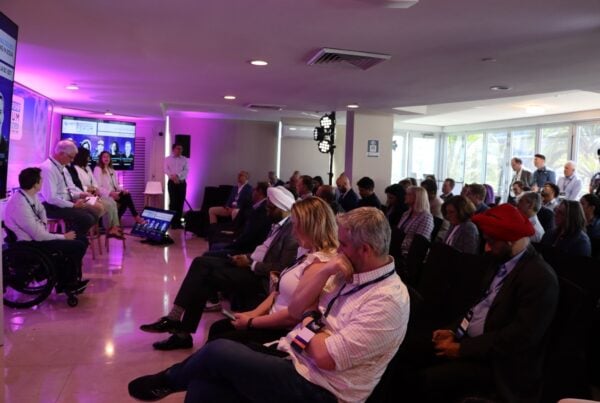Andrew Parkin-White, Founding Partner of TecFutures, shares an overview of a panel at MEF Global Forum in Barcelona, discussing the future of IoT. The panel was hosted by Nassia Skoulikariti, the Programme Director for IoT at MEF, and Andrew’s co-panellists were Nick Earle, CEO of Eseye, and Jimmy Jones, Head of Security at ZARIOT.
Nassia first asked the question around the major trends in the IoT ecosystem and where the industry is heading. Nick pointed to the importance of the requirement for multi-RAT (Radio Access Technology) agnostic connectivity and the shift away from MNO proprietary silos with a locked-in SIM, into an MVNO model that is agnostic and abstracted to enable interoperability between competing proprietary silos.

He continued that what we are now seeing is the need for not just interoperability between operators but interoperability between all types of connectivity in the device. Satellite with a cellular modem is an emerging trend and he also identified private networks and the importance of private to public network switching.
In Nick’s view, enterprises find the device the most difficult part of the IoT implementation. A recent enterprise survey by Eseye reports that 84% of enterprises who have tried to undertake an IoT project have found the device the most difficult element. The device has to have the intelligence to sense network capabilities such as latency, speed, and signal strength and actually make decisions at the device rather than platform level that are agnostic to the underlying model. He sees the emergence of significant new opportunities in this space, with the consumer and business world coming together.
What about the importance of IoT security as a key driver and adhering to new regulations? Jimmy stressed that with security, an understanding of the whole IoT solution is critical covering the device, the network and the application. Without an understanding of these elements, you cannot be sufficiently protected and a consolidated solution is required. He reiterated that the device is actually the key here and it has to be secure. Interoperability is also an important consideration and working with partners to achieve end-to-end encryption is paramount.
Jimmy continued by discussing the IoT security regulations that will be coming into play including the radio equipment directive in the EU and new IoT security regulations in the UK. These will place more focus on and heighten concerns around security and compliance. He stressed that IoT security does not currently attract a large spend despite it being a concern by a significant contingent of organisations. Supplier collaboration across the IoT ecosystem is essential to having secure applications.
Andrew’s view was that, as an external analyst, he is seeing that we are reaching a point of inflection in IoT. The market is moving beyond the pioneering organisations and IoT is now moving into the mainstream. Enterprises are looking for simplicity, a solution that is easy to configure and ideally sector-based. Expected growth rates are around 8% and anticipates a shakeout in the supply-side of the IoT market.
The share of connectivity as part of the overall IoT value chain revenue is also falling to around 8% for every dollar spent by enterprises on IoT from 10% a few years earlier. This raises the issue that connectivity providers urgently need to bolster their efforts to offer more non-connectivity wraparounds including security, analytics and service management tools. They can no longer own the entire value chain.
A consistent theme throughout the discussion was the importance of the business case and Nick stated that this should always be the starting point. IoT projects may be run by technical departments but organisations should adopt IoT solutions on the basis of the business case. Andrew supported Nick’s view saying that the drivers we see in enterprises using IoT is to create business advantage and improve the customer experience. Enterprises need support throughout the design-build-implement process and definitely need firm guidance around security issues.
Finally, Nick referred to the growing trend towards enterprise looking to achieve digital disruption around interaction with things. The value in IoT is in pulling these various elements together for the enterprise and delivering business advantage.
This guest post originally appeared on the TecFutures Blog and is reprinted here with kind permission






